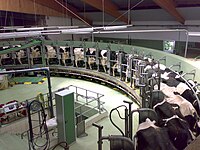
Photo from wikipedia
The objective of the present study was to compare serum IgG concentration, weight gain, and health characteristics in Irish spring-born dairy calves fed colostrum stored using a range of conditions.… Click to show full abstract
The objective of the present study was to compare serum IgG concentration, weight gain, and health characteristics in Irish spring-born dairy calves fed colostrum stored using a range of conditions. Immediately after birth, 75 dairy heifer calves were assigned to 1 of 5 experimental colostrum treatments: (1) fresh pasteurized colostrum, fed immediately after pasteurization; (2) fresh colostrum, fed immediately after collection but not pasteurized; (3) colostrum stored unpasteurized at 4°C in a temperature-controlled unit for 2d before being fed to calves; (4) colostrum stored unpasteurized at 13°C in a temperature-controlled unit for 2d before being fed to calves; and (5) colostrum stored unpasteurized at 22°C in a temperature-controlled unit for 2d before being fed to calves. All colostrum had IgG concentrations >50g/L and was fed to calves promptly after birth. Blood samples were obtained from calves via the jugular vein at 0h (before colostrum feeding) and at 24h of age to determine the rate of passive transfer of IgG; individual calf live-weights were recorded to monitor weight gain (kg/d) from birth to weaning. Colostrum stored in warmer conditions (i.e., 22°C) had >42 times more bacteria present and a pH that was 0.85 units lower and resulted in a serum IgG concentration that was almost 2 times lower compared with colostrum that was pasteurized, untreated, or stored at 4°C for 2d. Colostrum stored at 4°C for 2d had more bacteria present than pasteurized and fresh colostrum but did not result in reduced calf serum IgG concentrations. Average daily weight gain from birth to weaning did not differ among treatments. Even if colostrum has sufficient IgG (>50g/L) but cannot be fed to calves when freshly collected, storage at ≤4°C for 2d is advisable to ensure adequate passive transfer when it is consumed by the calf.
Journal Title: Journal of dairy science
Year Published: 2017
Link to full text (if available)
Share on Social Media: Sign Up to like & get
recommendations!